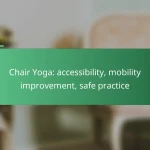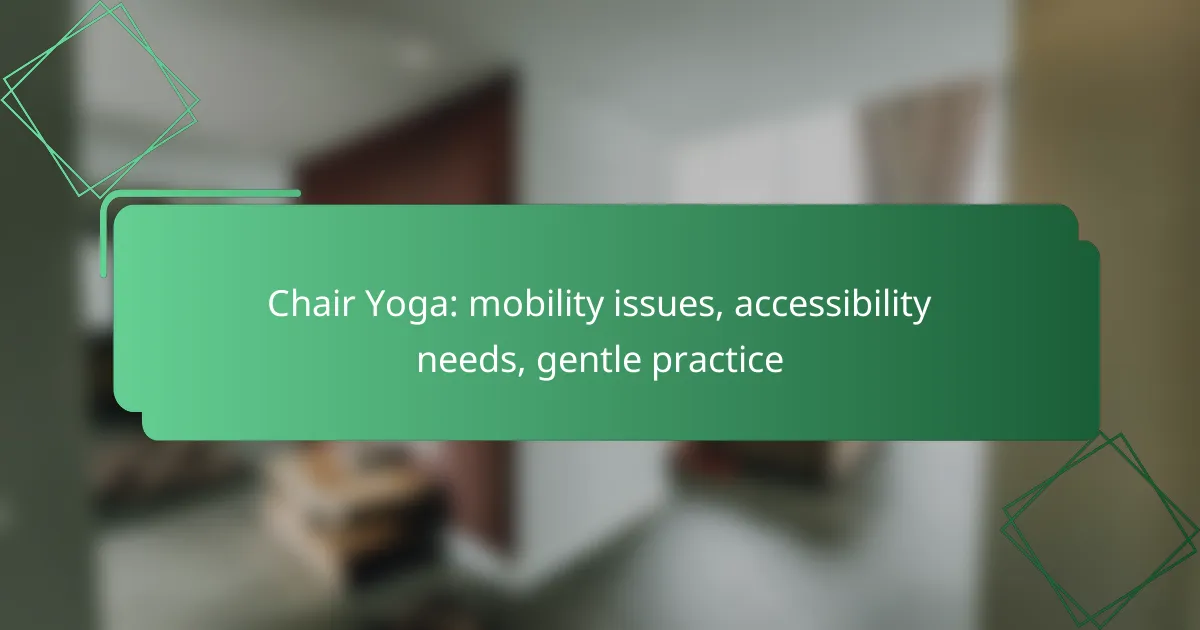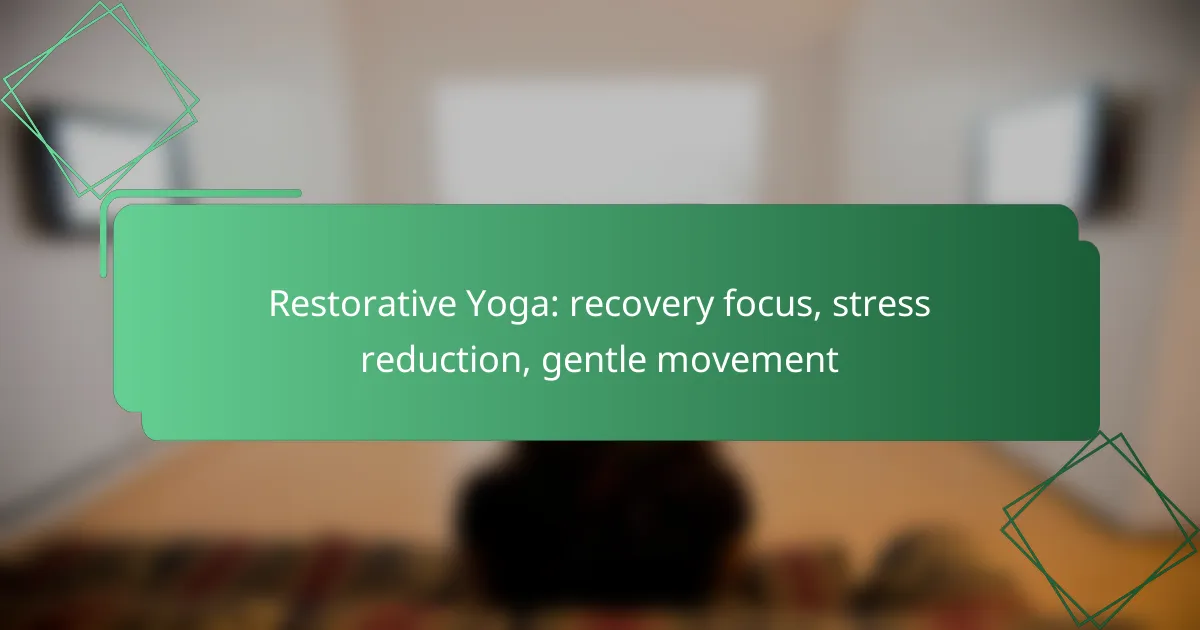Chair Yoga offers a gentle and accessible way for individuals with mobility issues to engage in physical activity while seated. This practice focuses on easy-to-perform movements that enhance flexibility and overall well-being, making it ideal for those facing physical challenges. By participating in Chair Yoga, seniors and others can improve their mobility in a supportive and accommodating environment.
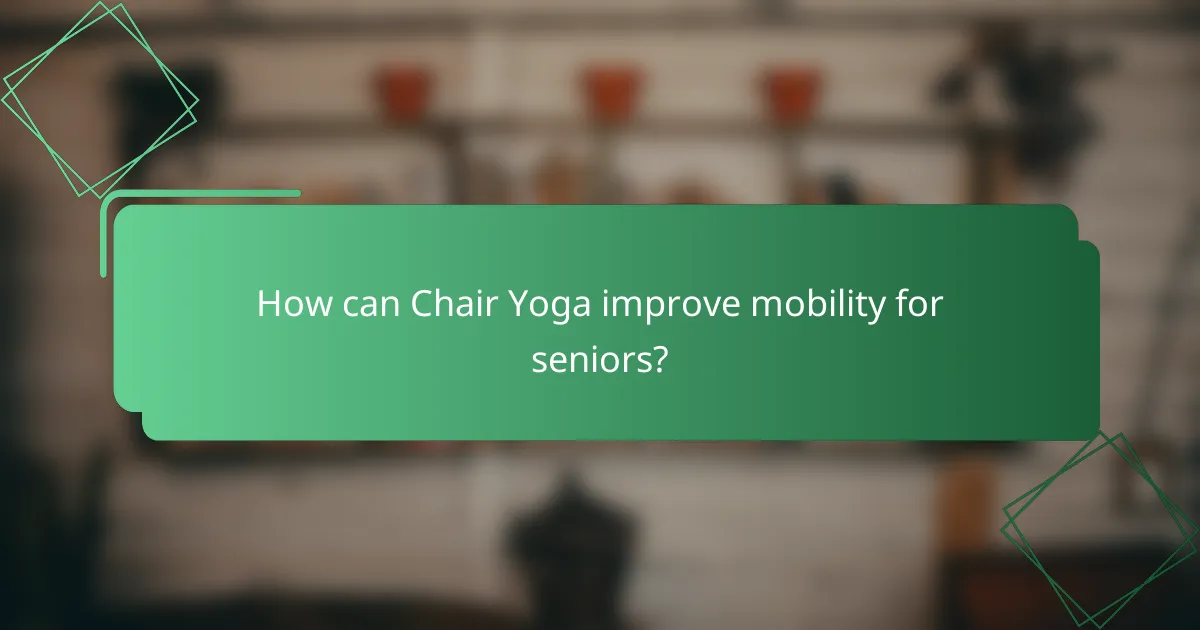
How can Chair Yoga improve mobility for seniors?
Chair Yoga can significantly enhance mobility for seniors by providing a gentle, accessible way to engage in physical activity. This practice focuses on movements that are easy to perform while seated, making it ideal for those with limited mobility or physical challenges.
Enhances joint flexibility
Chair Yoga promotes joint flexibility through a variety of gentle stretches and movements that target major joints like the hips, knees, and shoulders. Regular practice can help seniors maintain or improve their flexibility, which is crucial for daily activities.
To enhance joint flexibility, seniors can incorporate simple exercises such as seated leg extensions or arm circles. These movements can be performed multiple times a week to gradually increase flexibility.
Reduces muscle stiffness
Engaging in Chair Yoga can effectively reduce muscle stiffness, which is common among seniors due to inactivity or age-related changes. The gentle movements help to warm up the muscles, improving circulation and reducing tension.
Simple techniques like seated side bends or gentle torso twists can alleviate stiffness. Practicing these exercises regularly can lead to noticeable relief and increased comfort during daily tasks.
Increases range of motion
Chair Yoga helps increase the range of motion by encouraging seniors to move their limbs and joints through various positions. This practice can help counteract the effects of prolonged sitting or inactivity.
Incorporating movements such as ankle circles or wrist stretches can enhance mobility. Seniors should aim to perform these exercises consistently to see improvements in their overall range of motion.
Promotes better posture
Chair Yoga encourages better posture by strengthening core muscles and increasing awareness of body alignment. Good posture is essential for reducing strain on the back and neck, which can be particularly beneficial for seniors.
Exercises like seated mountain pose or gentle spinal twists can help reinforce proper alignment. Regular practice can lead to improved posture, making everyday activities easier and more comfortable.
Improves balance and stability
Chair Yoga can significantly improve balance and stability, which are critical for preventing falls among seniors. The practice includes movements that enhance coordination and strengthen stabilizing muscles.
Incorporating exercises such as seated leg lifts or gentle side leg raises can help build strength in the legs and core. Seniors should focus on these movements to enhance their overall stability and confidence in their mobility.
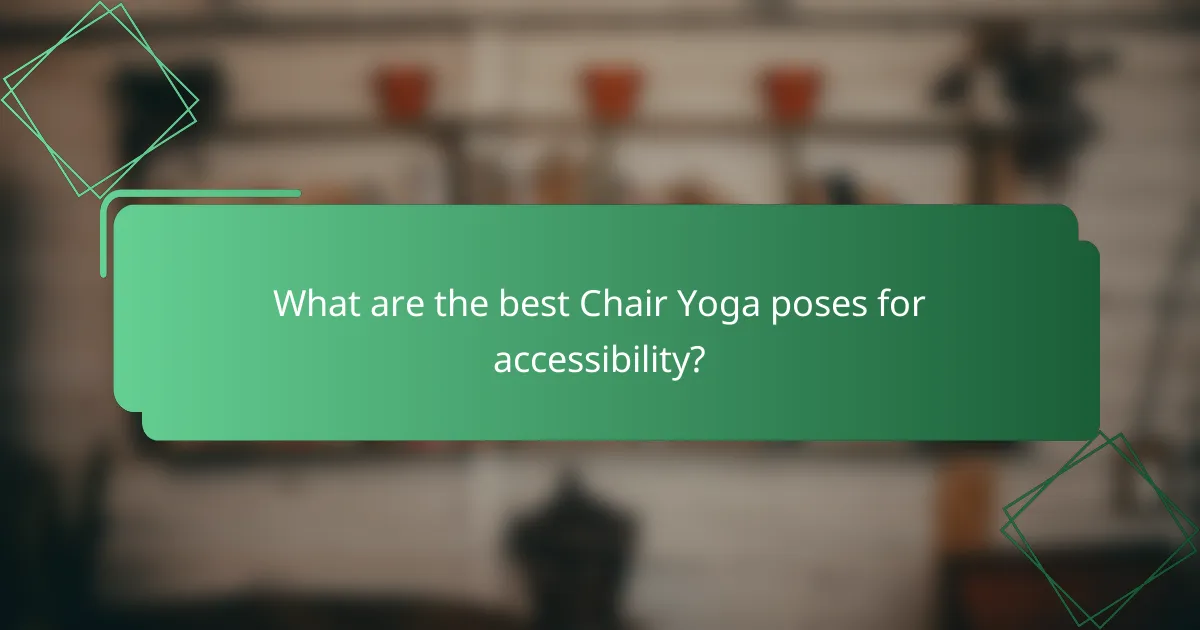
What are the best Chair Yoga poses for accessibility?
Chair Yoga poses designed for accessibility focus on gentle movements that can be performed while seated. These poses help improve mobility, flexibility, and overall well-being for individuals with mobility issues or accessibility needs.
Seated Mountain Pose
The Seated Mountain Pose is a foundational pose that promotes good posture and grounding. Sit up straight in your chair with your feet flat on the floor, hip-width apart, and arms resting at your sides or raised overhead.
To enhance this pose, engage your core and take deep breaths, feeling the lengthening of your spine. Hold for several breaths, focusing on stability and balance.
Chair Cat-Cow Stretch
The Chair Cat-Cow Stretch is excellent for spinal flexibility and relieving tension in the back. Start by sitting at the edge of your chair with your feet flat on the ground.
Inhale as you arch your back and lift your chest (Cow), then exhale as you round your spine and tuck your chin (Cat). Repeat this sequence several times, synchronizing your breath with the movements.
Seated Forward Bend
The Seated Forward Bend helps stretch the back and hamstrings while promoting relaxation. While seated, keep your feet flat and slowly hinge forward at the hips, reaching towards your feet or the floor.
Maintain a straight back as you lean forward, and hold the position for a few breaths. If you cannot reach your feet, rest your hands on your thighs or shins instead.
Seated Spinal Twist
The Seated Spinal Twist enhances spinal mobility and aids digestion. Sit tall in your chair and place your right hand on the back of the chair while twisting your torso to the right.
Hold the twist for several breaths, then return to center and repeat on the left side. Ensure your movements are gentle and controlled to avoid strain.
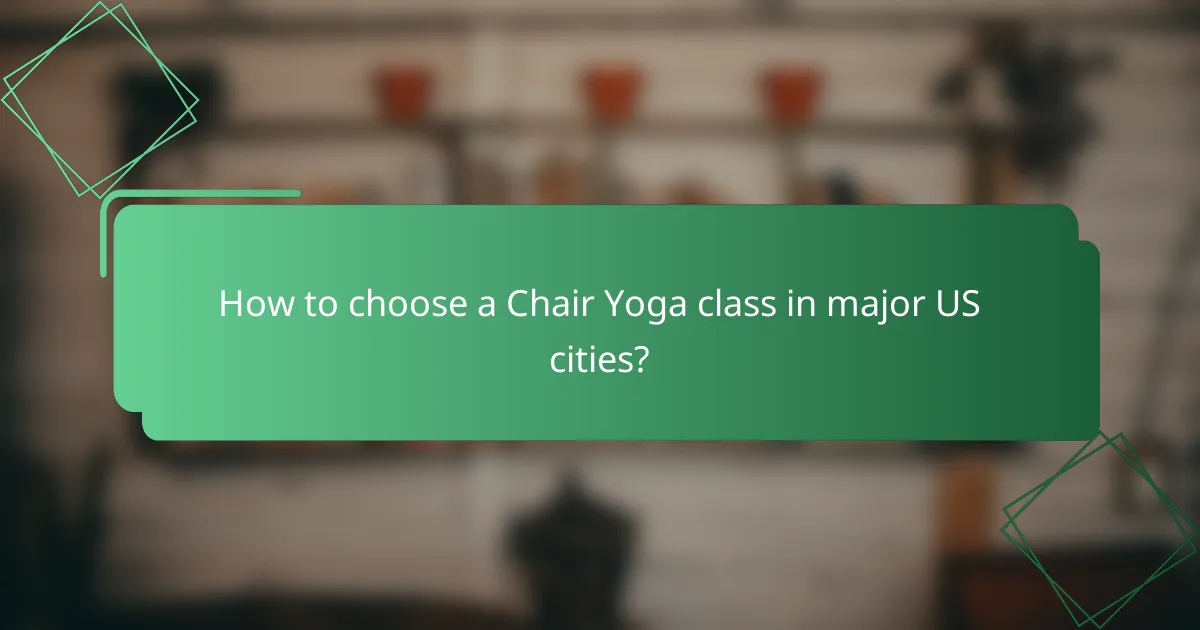
How to choose a Chair Yoga class in major US cities?
Choosing a Chair Yoga class in major US cities involves considering factors like instructor qualifications, class reviews, accessibility, and available formats. Prioritize classes that cater to your specific mobility needs and preferences for a supportive experience.
Look for certified instructors
When selecting a Chair Yoga class, ensure the instructor is certified in adaptive or chair yoga. Certified instructors have undergone training to understand the unique needs of individuals with mobility issues, ensuring a safe and effective practice.
Check for credentials from recognized organizations, such as Yoga Alliance or the International Association of Yoga Therapists. This can provide peace of mind that the instructor is knowledgeable and experienced in working with diverse accessibility needs.
Check class reviews and ratings
Reviews and ratings can provide insight into the quality of a Chair Yoga class. Look for feedback from previous participants, especially those with similar mobility challenges, to gauge the instructor’s effectiveness and the overall class environment.
Websites like Yelp or Google Reviews can be useful for finding honest opinions. Aim for classes with consistently high ratings and positive comments about inclusivity and instructor support.
Assess class size and accessibility
Class size can significantly impact your experience in Chair Yoga. Smaller classes often allow for more personalized attention and adjustments, which can be beneficial for those with specific mobility needs.
Additionally, ensure the studio or location is accessible, with features such as ramps, wide doorways, and appropriate seating. Confirm that the class is held in a space that accommodates wheelchairs and other mobility aids.
Consider online options
Online Chair Yoga classes can be a convenient alternative, especially for those with mobility issues or who prefer practicing at home. Many platforms offer live-streamed or recorded sessions that cater to various skill levels and accessibility needs.
Look for reputable websites or instructors that provide clear instructions and modifications for different abilities. This flexibility allows you to practice at your own pace and comfort level, making it easier to integrate yoga into your routine.

What are the benefits of Chair Yoga for individuals with disabilities?
Chair Yoga offers numerous benefits for individuals with disabilities, focusing on enhancing mobility, flexibility, and overall well-being. This gentle practice allows participants to engage in yoga without the need for traditional floor poses, making it accessible and adaptable for various physical limitations.
Promotes inclusivity
Chair Yoga is designed to be inclusive, allowing individuals with diverse mobility issues to participate fully. By using a chair as a support, practitioners can perform poses that may otherwise be difficult or impossible on the floor. This accessibility fosters a welcoming environment where everyone can practice together, regardless of their physical abilities.
Classes can be tailored to meet the needs of participants, ensuring that modifications are available for different levels of ability. This adaptability encourages individuals to explore their capabilities without feeling excluded.
Encourages mental well-being
Engaging in Chair Yoga can significantly enhance mental well-being by reducing stress and promoting relaxation. The gentle movements and focused breathing help to calm the mind, making it easier for participants to manage anxiety and depression. Regular practice can lead to improved mood and a greater sense of peace.
Mindfulness techniques incorporated into Chair Yoga also encourage participants to connect with their bodies and emotions. This awareness can foster a positive self-image and boost self-esteem, which is particularly beneficial for individuals facing physical challenges.
Facilitates social interaction
Chair Yoga classes provide a unique opportunity for social interaction among individuals with disabilities. Practicing in a group setting allows participants to connect with others who share similar experiences, fostering a sense of community and support. These connections can lead to lasting friendships and a stronger social network.
Additionally, the shared experience of practicing Chair Yoga can help break down barriers and promote understanding among participants. This social aspect is essential for enhancing overall quality of life, as it encourages engagement and reduces feelings of isolation.
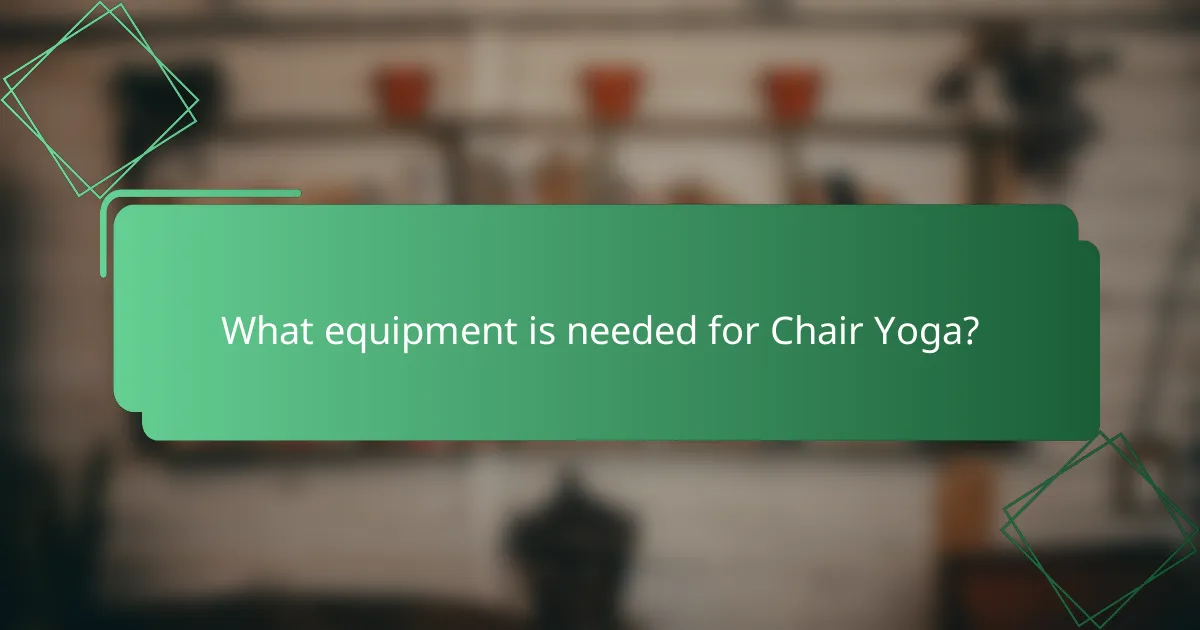
What equipment is needed for Chair Yoga?
Chair Yoga requires minimal equipment, primarily a sturdy chair that provides good support and stability. Additional props like resistance bands or light weights can enhance the practice but are not essential.
Sturdy chair
A sturdy chair is the foundation of Chair Yoga, ensuring safety and comfort during practice. Look for a chair that has a firm seat, a straight back, and no arms to allow for a full range of motion.
When selecting a chair, consider options like a dining chair or a folding chair that can support your weight without wobbling. The height should allow your feet to rest flat on the floor while sitting, promoting proper alignment.
Check that the chair’s legs are stable and non-slip, especially if you will be moving in and out of different positions. Avoid chairs with wheels or those that are too low, as they can pose a risk of falling or straining while transitioning.



